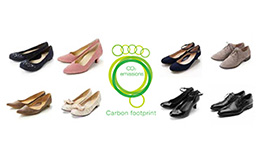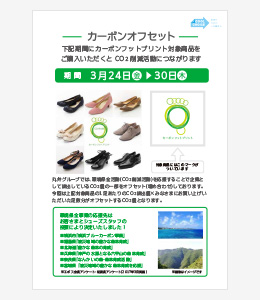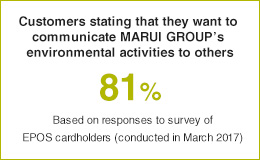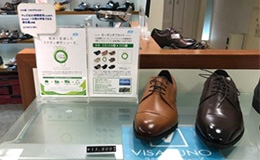Integrated Group Efforts to Reduce Environmental Footprint
- MARUI GROUP Environmental Policy
- Initiatives for Combating Climate Change Together with Business Partners and Customers
- Decarbonization and Resource Conservation Initiatives
- Carbon Footprints
- Carbon Offset
- Incorporating Reduction into Business Activities
- Reuse Promoted through Clothing and Shoe Trade-in Programs
- Waste Reduction from Preventing the Creation of Products that Go Unused
- Ecological Network of Biodiversity
Carbon Footprints
MARUI GROUP has continued to implement carbon footprint initiatives since 2009 to track CO2 emissions across the value chain in order to reduce environmental impacts and facilitate co-creation activities with business partners.
We provide in-store displays about our carbon footprint initiatives to inform all customers of these efforts, not just those concerned about environmental issues. By informing customers about eco-friendly products, we think that we can help motivate customers to make conscious decisions when selecting products and thereby propose ecological lifestyles.

-
59 eco-friendly products launched in the fiscal year ended March 31, 2022


Carbon footprint-tracked products
| Shoes | 37 styles |
| Pants | 11 styles |
| Bags | 7 styles |
| Handkerchiefs | 4 styles |
| Total | 59 styles |
Distribution of CO2 Emissions over Lifecycle of Shoes (Average for women's shoes)


Carbon Offset
MARUI GROUP has employed carbon offset schemes since 2009 as an ecological action for offsetting emissions of CO2 and other greenhouse gases that it is unable to reduce in its own operations through reductions or the absorption of emissions elsewhere. (These activities were canceled in the fiscal year ended March 31, 2021, in response to the COVID-19 pandemic.)
Since 2014, we have been conducting carbon offset initiatives in disaster-stricken areas as well as in the areas that produce material for our shoes, the areas in which we open new stores, and other areas that benefit local customers.
New Initiative in 2017
In 2017, we decided the target location for carbon offset initiatives based on a survey of around 1,000 customers and votes by employees. Only around 20% of customers that took the survey were aware of carbon offset schemes, but through the survey many came to resonate with and take interest in MARUI GROUP's initiatives. MARUI GROUP plans to continue such initiatives into the future in order to broaden the scope of the environmental activities it co-creates with customers.

Feedback from Customers
- I now want to research carbon offset schemes more.
- As a fan of the Rakuchin series, I am pleased to know that these products are friendly toward the environment.
- This was the first time I heard that MARUI GROUP was working to preserve the environment. I want to do my part too.

Carbon Offset Initiatives to Date
| 2009– January 2014 |
109 t-CO2 | Offset CO2 emissions associated with sales of VISARUNO dress shirts |
| March 2015 | 25 t-CO2 | Offset CO2 emissions associated with sales of Rakuchin Kirei Pumps through programs supporting reconstruction from the Great Hanshin-Awaji earthquake and the Great East Japan Earthquake and programs for aiding the regions that produce the materials used in the pumps |
| June 2015 | 50 t-CO2 | Offset CO2 emissions associated with the transportation of employees that participated in planning meetings with customers related to the opening of Hakata Marui through programs that contribute to the city of Fukuoka |
| March and June 2016 |
50 t-CO2 | Offset CO2 emissions associated with sales of Rakuchin Kirei Pumps through two regional contribution programs: a program that contributed to Fukuoka City in light of the opening of Hakata Marui and a program that contributed to Kobe City, where the materials used in the pumps are produced |
| March 2017 | 68 t-CO2 | Offset CO2 emissions associated with sales of eight styles of shoes through a total of six regional contribution programs: three programs that were strongly supported by customers, one program voted for by sales staff, and two programs that contributed to shoe material-producing regions |
| September 2017 | 66 t-CO2 | Offset CO2 emissions associated with sales of 12 styles of shoes at seven sites: three sites selected based on customer support, two sites in the regions that produce these shoes, and two sites in Kumamoto and Akita prefectures, which were struck by natural disasters in 2017 |
| March 2018 | 95 t-CO2 | Offset CO2 emissions associated with sales of 28 types of products at six sites: three sites selected based on customer support, two shoes production sites, and one site in Miyagi Prefecture at which we produce stockings, which were newly included among the products applicable under carbon offset schemes |
| September 2018 | 139 t-CO2 | Offset CO2 emissions associated with sales of 54 types of applicable products at five sites selected with emphasis on municipal governments promoting solar power in order to facilitate the spread of renewable energy: two sites selected based on customer support; one site in Hyogo Prefecture, where applicable products are produced; and two sites in the disaster-stricken Tohoku and Kyushu regions |
| March 2019 | 137 t-CO2 | Offset CO2 emissions associated with sales of 70 types of applicable products at six sites: three sites selected based on customer support, two sites in regions impacted by the Great East Japan Earthquake, and one shoe production site |
| Total | 739 t-CO2 | |
This sustainability website is designed to accommodate people with color blindness.











